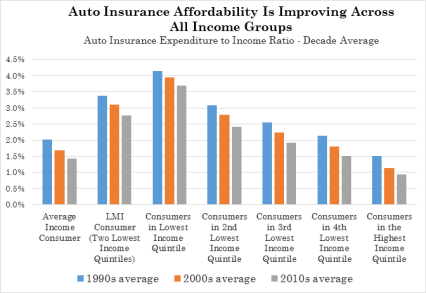Personal auto insurance has become more affordable over time for all income groups, including low-to-moderate income (LMI) groups, according to a new report from the Insurance Research Council (IRC). In addition to documenting that auto insurance has become more affordable for both the nation as a whole and across states, the study also showed that the degree of improvement in auto insurance affordability is not being witnessed in other critical industries.
The study, Trends in Auto Insurance Affordability, used an auto insurance expenditure-to-income ratio to analyze auto insurance affordability. The report’s findings do not to prescribe a specific threshold at which auto insurance may be considered affordable. Instead, it examines trends in affordability, thereby reducing the inherent subjectivity involved in affordability analysis.
The auto insurance expenditure-to-income ratio was calculated using insurance expenditure data from the National Association of Insurance Commissioners and, alternatively, from the Bureau of Labor Statistics Consumer Expenditure Survey. Both methods revealed dramatic improvements in national auto insurance affordability over the long-term for average and LMI consumers. Currently, about 1.5 percent to 1.6 percent of income is spent on auto insurance in the U.S. (depending on the data set used) by the average consumer, which represents much lower figures than seen in previous decades. LMI consumers have also witnessed similar trends.
 The study includes state estimates indicating that auto insurance affordability has also been improving in most states. All but five experienced improved affordability from the 1990s to the 2000s, and all but four have shown an improvement in affordability between the 2000s and the present. Affordability does vary across states, however. According to the report, auto insurance was least affordable in Louisiana (2.85 percent of income), Florida (2.45 percent), New York (2.42 percent), Delaware (2.18 percent) and Michigan (2.10 percent). The most affordable states were found to be North Dakota (1.03 percent of income), Iowa (1.05 percent), New Hampshire (1.06 percent), Virginia (1.07 percent) and Wyoming (1.08 percent).
The study includes state estimates indicating that auto insurance affordability has also been improving in most states. All but five experienced improved affordability from the 1990s to the 2000s, and all but four have shown an improvement in affordability between the 2000s and the present. Affordability does vary across states, however. According to the report, auto insurance was least affordable in Louisiana (2.85 percent of income), Florida (2.45 percent), New York (2.42 percent), Delaware (2.18 percent) and Michigan (2.10 percent). The most affordable states were found to be North Dakota (1.03 percent of income), Iowa (1.05 percent), New Hampshire (1.06 percent), Virginia (1.07 percent) and Wyoming (1.08 percent).
The report compares affordability trends for auto insurance to the affordability trends for other industries whose products or services are considered necessities. Auto insurance was found to represent a smaller percentage of the average consumer’s budget and LMI consumer’s budget. It also has had largely unprecedented affordability improvements over time.
“There is a lot of interest in the affordability of auto insurance on the part of consumers, policymakers and regulators. This report adds to the discussion, showing that auto insurance is becoming more and more affordable,” said Elizabeth Sprinkel, senior vice president of the IRC.
Source: Insurance Research Council
Was this article valuable?
Here are more articles you may enjoy.

 Marijuana’s Move to Schedule III: What it Really Means for Cannabis Insurance
Marijuana’s Move to Schedule III: What it Really Means for Cannabis Insurance  Instacart to Pay $60 Million in FTC Consumer Protection Case
Instacart to Pay $60 Million in FTC Consumer Protection Case  Trump Sues BBC for $10 Billion Over Documentary Edit
Trump Sues BBC for $10 Billion Over Documentary Edit  Poorer Americans Dropped Federal Flood Insurance When Rates Rose
Poorer Americans Dropped Federal Flood Insurance When Rates Rose 